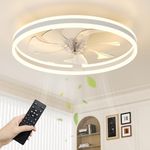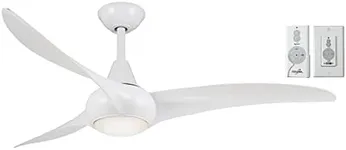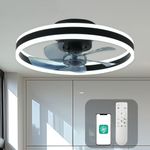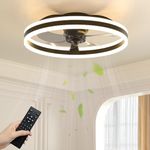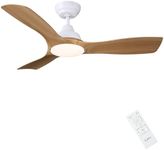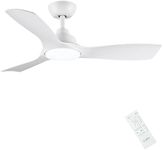Buying Guide for the Best Ceiling Fans
Choosing the right ceiling fan can significantly enhance the comfort and style of your living space. Ceiling fans are not only functional, providing air circulation and cooling, but they also add to the aesthetic appeal of a room. When selecting a ceiling fan, consider the size of the room, the height of the ceiling, and your personal style preferences. It's important to understand the key specifications that will affect the fan's performance and suitability for your space.SizeThe size of a ceiling fan is crucial because it determines how effectively the fan can circulate air in a room. Fan size is typically measured by the diameter of the blades. For small rooms up to 75 square feet, a fan with a blade span of 29 to 36 inches is ideal. Medium-sized rooms up to 144 square feet can benefit from a fan with a blade span of 36 to 42 inches. Larger rooms up to 225 square feet should have fans with a blade span of 50 to 54 inches. For very large rooms, consider fans with a blade span of 60 inches or more. Choosing the right size ensures efficient air circulation and comfort.
MotorThe motor is the heart of a ceiling fan, affecting its performance and noise level. Motors can be divided into AC and DC types. AC motors are common and generally more affordable, while DC motors are more energy-efficient and quieter, offering more speed options. If you prioritize energy savings and quiet operation, a fan with a DC motor might be the best choice. Consider your need for efficiency and noise level when selecting the motor type.
Blade MaterialBlade material impacts both the durability and appearance of a ceiling fan. Common materials include wood, metal, and plastic. Wooden blades offer a classic look and are quieter, but may warp in humid conditions. Metal blades are durable and modern but can be noisier. Plastic blades are versatile and resistant to moisture, making them suitable for outdoor use. Choose a blade material that complements your room's decor and suits the environmental conditions.
AirflowAirflow, measured in cubic feet per minute (CFM), indicates how much air a fan can move. Higher CFM values mean more air circulation, which is important for cooling larger spaces. Fans with a CFM rating of 4,000 to 5,000 are suitable for small rooms, while larger rooms may require fans with a CFM of 5,000 to 6,000 or more. Consider the size of your room and your cooling needs when evaluating airflow.
Control OptionsControl options determine how you operate your ceiling fan. Basic fans may have pull chains, while more advanced models offer remote controls or wall switches. Some fans are compatible with smart home systems, allowing for voice control and automation. If convenience and integration with smart home devices are important to you, opt for a fan with advanced control options. Consider how you prefer to interact with your fan when choosing control features.
LightingMany ceiling fans come with integrated lighting, which can be a practical addition to your room. Consider the type of lighting, such as LED or incandescent, and the style of the light fixture. LED lights are energy-efficient and long-lasting, while incandescent bulbs offer a warmer glow. If your room requires additional lighting, choose a fan with a built-in light kit that matches your lighting needs and aesthetic preferences.
